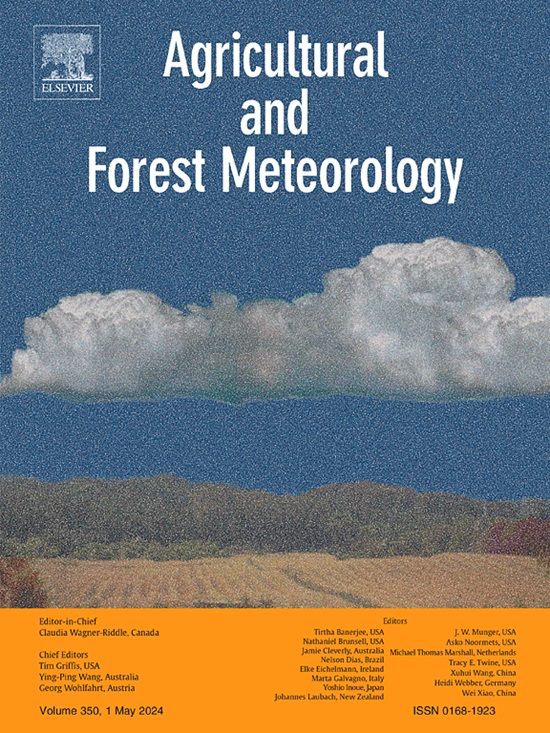Land use and climatic drivers of early 21st-century fire activity in the Amazon
IF 5.7
1区 农林科学
Q1 AGRONOMY
引用次数: 0
Abstract
Fire plays a critical role in shaping the Amazon’s ecosystem and carbon dynamics, yet the relative contributions of climatic and land-use drivers remain debated. Here, we used 0.5° by 0.5° aggregated satellite-based active fire (AF) data (2002–2020) combined with land-cover change and climate reanalysis datasets to (1) quantify spatiotemporal change of fire patterns, (2) evaluate the interrelationships between drought, deforestation, and fires while comparing the relative contributions of climatic and land-use drivers, and (3) assess the impact of policy interventions on fire incidence. Our findings reveal that, despite a declining trend in overall fire detections, fire activity has shifted from regional concentration to broader dispersion, advancing deeper into the forest interior. While drought anomalies account for approximately 30 % of fire variability, spatial regression analysis highlights the dominant role of deforestation (coefficient=0.67) and farmland expansion (coefficient=0.20), compared to drought (coefficient=0.05). Notably, deforestation’s contribution to positive fire anomalies declined from ∼ 69 % (Phase I: 2004–2008) to ∼ 41 % (Phase IV: 2016–2020) of the Action Plan for the Prevention and Control of Deforestation in the Legal Amazon (PPCDAm), reflecting the partial effectiveness of conservation policies in mitigating fire risk. Nevertheless, the persistent interaction among fires, deforestation, and farmland expansion underscores the critical role of human activities in creating ignition-prone landscapes and stimulating fire occurrences. This study demonstrates the compounding effects of climate and land-use changes on Amazonian fire dynamics, and emphasizes the urgent need for integrated land use policies and climate adaptation strategies to address the enduring fire pressures and safeguard the Amazon’s carbon stocks and biodiversity.
21世纪初亚马逊地区火灾活动的土地利用和气候驱动因素
火灾在塑造亚马逊生态系统和碳动态方面发挥着关键作用,但气候和土地利用驱动因素的相对贡献仍存在争议。本文利用2002-2020年的0.5°× 0.5°卫星活火(AF)汇总数据,结合土地覆盖变化和气候再分析数据集(1)量化火灾模式的时空变化;(2)评估干旱、森林砍伐和火灾之间的相互关系,同时比较气候和土地利用驱动因素的相对贡献;(3)评估政策干预对火灾发生率的影响。我们的研究结果表明,尽管总体火灾探测呈下降趋势,但火灾活动已经从区域集中转向更广泛的分散,向森林内部深入。虽然干旱异常约占火灾变异的30%,但空间回归分析表明,与干旱(系数=0.05)相比,森林砍伐(系数=0.67)和农田扩张(系数=0.20)发挥了主导作用。值得注意的是,在《亚马孙合法森林砍伐防治行动计划》(PPCDAm)中,森林砍伐对积极火灾异常的贡献从69%(第一阶段:2004-2008年)下降到41%(第四阶段:2016-2020年),这反映了保护政策在减轻火灾风险方面的部分有效性。然而,火灾、森林砍伐和农田扩张之间持续的相互作用强调了人类活动在创造易燃性景观和刺激火灾发生方面的关键作用。该研究揭示了气候和土地利用变化对亚马逊雨林火灾动态的复合影响,并强调迫切需要制定综合土地利用政策和气候适应战略,以应对持续的火灾压力,保护亚马逊雨林的碳储量和生物多样性。
本文章由计算机程序翻译,如有差异,请以英文原文为准。
求助全文
约1分钟内获得全文
求助全文
来源期刊
CiteScore
10.30
自引率
9.70%
发文量
415
审稿时长
69 days
期刊介绍:
Agricultural and Forest Meteorology is an international journal for the publication of original articles and reviews on the inter-relationship between meteorology, agriculture, forestry, and natural ecosystems. Emphasis is on basic and applied scientific research relevant to practical problems in the field of plant and soil sciences, ecology and biogeochemistry as affected by weather as well as climate variability and change. Theoretical models should be tested against experimental data. Articles must appeal to an international audience. Special issues devoted to single topics are also published.
Typical topics include canopy micrometeorology (e.g. canopy radiation transfer, turbulence near the ground, evapotranspiration, energy balance, fluxes of trace gases), micrometeorological instrumentation (e.g., sensors for trace gases, flux measurement instruments, radiation measurement techniques), aerobiology (e.g. the dispersion of pollen, spores, insects and pesticides), biometeorology (e.g. the effect of weather and climate on plant distribution, crop yield, water-use efficiency, and plant phenology), forest-fire/weather interactions, and feedbacks from vegetation to weather and the climate system.

 求助内容:
求助内容: 应助结果提醒方式:
应助结果提醒方式:


